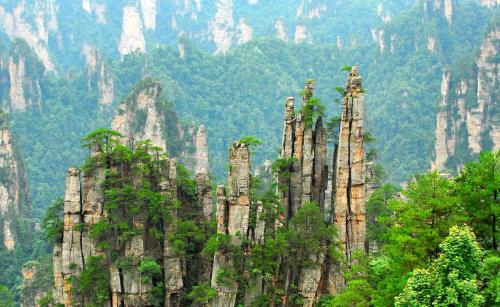
Aerial Paddy Fields in Tianzi Mountain, Zhangjiajie
Introduction
Nestled amidst the breathtaking landscapes of Tianzi Mountain in Zhangjiajie National Forest Park, the Aerial Paddy Fields, locally known as "空中田园" (Kōngzhōng Tiányuán), are a testament to human resilience and the harmonious coexistence between man and nature. This small but extraordinary piece of cultivated land, covering a mere 3.9 mu (approximately 0.65 acres), stands out as a beacon of human ingenuity amidst the towering peaks and verdant valleys. Perched precariously on a mountaintop over a thousand meters above sea level, the fields resemble a giant figure "8" and appear to float among the clouds, hence their evocative name.
The Tale of Resilience: The Story Behind the Aerial Paddy Fields
The Aerial Paddy Fields owe their existence to the unwavering determination of Peng Qiyun, a local Tujia farmer. Born and raised in the unforgiving terrain of Tianzi Mountain, Peng, along with his eight-member family, had long struggled to eke out a living from their meager plots of land. Driven by the need to provide for his own family after marriage, Peng embarked on a daunting mission: to carve out arable land from the seemingly impenetrable mountainside.
Starting in 1983, Peng and his wife dedicated themselves to this backbreaking endeavor. Day after day, they tirelessly chipped away at the rock face, moved boulders, and hauled soil to create their mountaintop oasis. This arduous process, fraught with challenges and setbacks, spanned five long years. Finally, in 1988, their dream became a reality as they successfully cultivated their first crops on the newly christened Aerial Paddy Fields.
| Task | Description | |--------------------|----------------------------------------------------------------------------------| | Chiseling Rocks | Breaking down large rocks using rudimentary tools to create workable space. | | Moving Boulders | Transporting heavy rocks to build retaining walls and clear the land. | | Soil Transportation | Carrying fertile soil from lower altitudes to compensate for the barren mountaintop. | | Soil Improvement | Mixing the transported soil with organic matter to enhance its fertility. | | Irrigation | Constructing a system to channel water from a nearby mountain spring to the fields. |
A Farmer's Triumph: Peng Qiyun and His Legacy

☝ Peng Qiyun being interviewed
Initially, the soil yielded meager harvests, a constant source of worry for Peng. Undeterred, he sought ways to improve its fertility. He collected wild animal dung and burnt vegetation to create ash, diligently incorporating these natural fertilizers into the soil. His persistence paid off; gradually, the land flourished, rewarding him with bountiful harvests of rice, vegetables, and fruits.
For years, the Aerial Paddy Fields remained a hidden gem, known only to the locals. It wasn't until 2009, when a South Korean couple shared pictures of this remarkable sight online, that the world took notice. The images went viral, catapulting the Aerial Paddy Fields to fame and earning them a coveted spot among Zhangjiajie's top ten scenic attractions.
Today, while Peng and his family have relocated to the more accessible lowlands, in accordance with government initiatives, he continues to tend to his beloved fields. Visitors to the Aerial Paddy Fields still have the opportunity to meet this remarkable man – a farmer, a visionary, and now, an internet celebrity.
The Transformation: From Paddy Fields to "Sky Garden"

☝ The Aerial Paddy Fields in winter
Historically, the Aerial Paddy Fields provided sustenance, with Peng cultivating staples like rice, rapeseed, buckwheat, and potatoes. However, as his economic conditions improved, Peng shifted his focus in 2017. Instead of solely planting crops for sustenance, he embarked on a new mission: transforming the fields into a "landscape" of their own. The dry fields are now adorned with vibrant rapeseed blossoms and azaleas, while the paddy fields bloom with exquisite lotuses, creating a symphony of colors that change with the seasons.
This shift signifies a new chapter for the Aerial Paddy Fields. No longer just a testament to agricultural ingenuity, they are evolving into an "Aerial Garden" – a testament to the enduring bond between humans and nature, where beauty and sustenance intertwine.
Q&A
Q: How long did it take to create the Aerial Paddy Fields? A: It took Peng Qiyun and his wife five years, from 1983 to 1988, to carve out the Aerial Paddy Fields.
Q: What makes the soil fertile now? A: Peng Qiyun's dedication to improving the soil by adding natural fertilizers like animal dung and burnt vegetation has made it fertile over the years.
Q: What is the future of the Aerial Paddy Fields? A: Peng Qiyun envisions transforming the Aerial Paddy Fields into a breathtaking "Sky Garden," focusing on cultivating flowers and scenic plants rather than solely focusing on crops for sustenance.